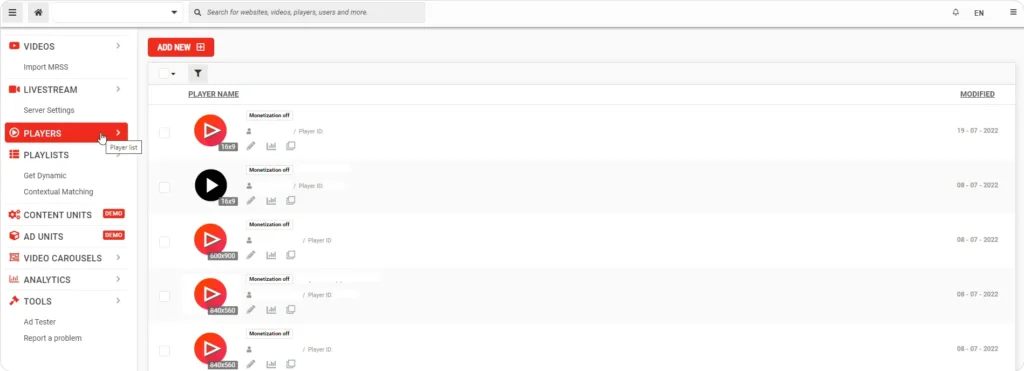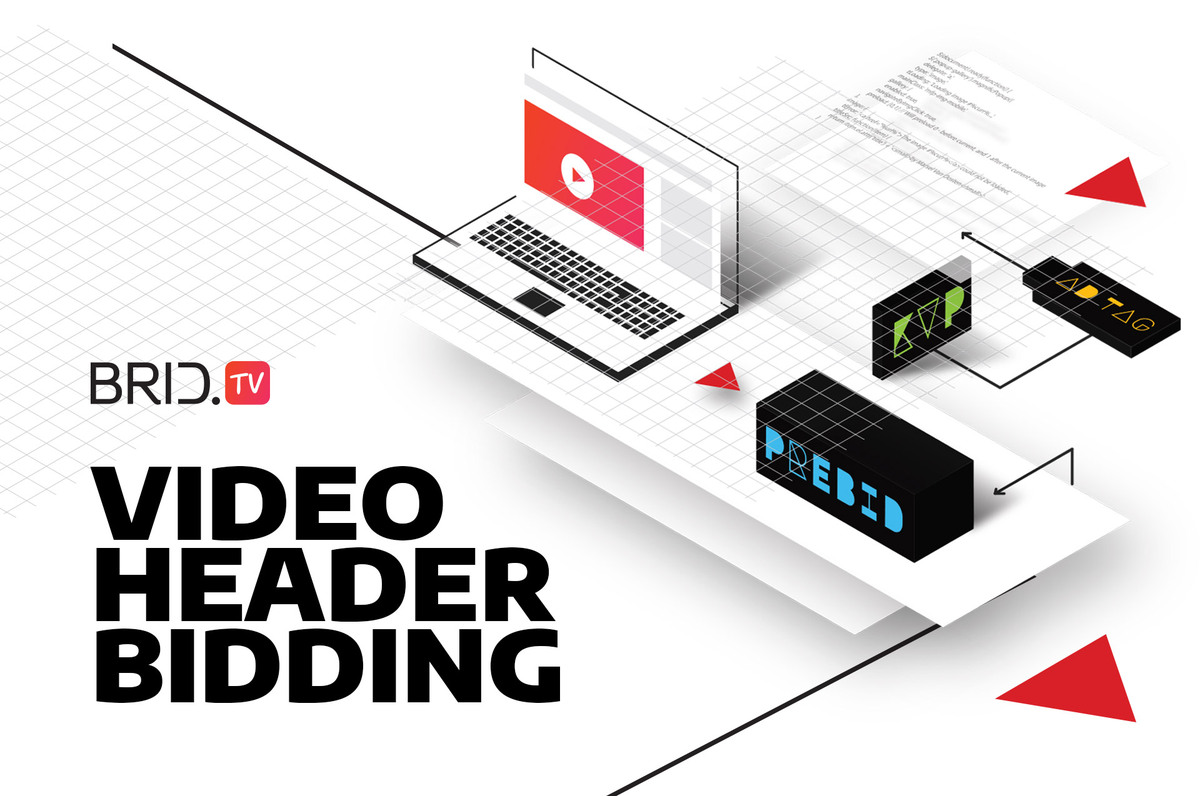Video advertising has been gaining popularity at an incredible speed in the last decade or so. With it, video ad tech has been developing to keep up with the increasing demand. One of the most sophisticated pieces of ad technology we have seen appear recently is video header bidding. But what is header bidding exactly, and do you really need it in order to monetize content? Let’s find out!
- What Is Video Header Bidding?
- How Does Video Header Bidding Work?
- The Differences Between Header Bidding and Real-Time Bidding
- Why Publishers Are Turning Away From Traditional Programmatic Toward Header Bidding Solutions
- The Biggest Challenges of Switching to Video Header Bidding
- How to Find the Best Video Header Bidding Partner
- How to Implement Video Header Bidding
- Are You Ready to Switch to Header Bidding?
- FAQ
What Is Video Header Bidding?
Header bidding is an advanced method of trading in ad inventory that speeds up the process and optimizes ad revenue for publishers. Video header bidding, then, is a type of header bidding used for video advertisements.
Header bidding is a type of real-time bidding (RTB), and it has been around since the mid-2010s. It is the modern, more efficient alternative to waterfalling, another ad trading method.
How Does Video Header Bidding Work?
So we have established that video header bidding is more time-efficient for all parties and more profitable for publishers. But how does it actually work?
The main purpose of video header bidding, or header bidding in general, is to allow multiple demand sources to bid on the same piece of inventory at the same time. So when a user plays a video, the player sends an ad request. Then, several ad exchanges, ad networks, and SSPs place their bids for that impression simultaneously. The demand source that offers the highest amount wins the auction and serves a video ad.
There are two types of header bidding — client-side and server-side. Although the process itself is more or less the same in either case, there is one major difference, and that’s the place where the auction happens.
Client-Side Video Header Bidding
Here’s what the process of client-side video header bidding looks like step-by-step:
- A user plays the publisher’s video.
- The player’s header bidding wrapper reaches out to supply-side platforms and ad exchanges.
- These SSPs and ad exchanges usually purchase creatives from demand-side platforms. With access to these creatives, they can place bids on the inventory.
- The bids are then forwarded back to the header bidding wrapper.
- The wrapper evaluates the bids and sends the highest bid to a third-party server, where the bid is cached. This ensures that all parties keep their end of the deal, that the winning bid is served to the end user, and that the publisher gets the promised CPM.
- If the publisher has their own ad server, the server compares this bid to any direct deals or private marketplace deals. It then picks the highest offer of all of them.
- The HTML player serves the video ad to the user.
This process can differ to some extent from publisher to publisher. For example, the publisher might not have an ad server, which means that that part of the process simply doesn’t happen.
Server-Side Video Header Bidding
Server-side video header bidding is quite similar. However, there is one additional party that participates in the process — the server-side header bidding vendor. Additionally, the auction itself takes place on the ad server, rather than the wrapper. With this in mind, the process of server-side video header bidding looks something like this:
- A user begins to play the publisher’s video.
- The player’s header bidding wrapper calls a server-side header bidding provider such as Prebid Server.
- This provider then forwards the ad request to SSPs and ad exchanges, which place their bids for the inventory.
- The server-side header bidding vendor then evaluates all the bids and forwards the winning one to the publisher’s ad server. The server compares the winning bid with private marketplace and direct deals.
- If the publisher doesn’t have an ad server, the bid goes directly to a third-party server for caching.
- Once the highest bid has been selected, the player serves the video ad to the user.
So Which Is Better?
Server-side and client-side header bidding might be quite similar, but they are not equally as efficient. Namely, with server-side bidding, the bulk of the process happens off-site, on a dedicated ad server. This stands in contrast to client-side bidding, which burdens the publisher’s website and the viewer’s network significantly.
As a result, server-side video header bidding is a much more time-efficient process, making it a better choice for publishers than its client-side counterpart.
The Differences Between Header Bidding and Real-Time Bidding
The terms header bidding and real-time bidding (RTB) are often used interchangeably. However, although they do overlap, they denote different things. We have already established what the former is, but what does RTB mean?
Real-time bidding is any ad auction that takes place in real time, i.e. when an ad request is sent. Put simply, header bidding is a type of real-time bidding.
Why Publishers Are Turning Away From Traditional Programmatic Toward Header Bidding Solutions
Ever since it came out in 2014, header bidding has been gaining popularity among publishers in all industries. But why is that so?
Compared to other programmatic advertising methods, namely waterfalling, header bidding is much more profitable for publishers. Waterfalling uses the cascading model of auctioning, which prioritizes buyers over publishers. The waterfall method accepts offers one by one and settles on the first one that meets the publisher’s price floor requirement.
On the other hand, header bidding allows all bidders to place offers at the same time and chooses the highest one. As a result, publishers can generate a higher ad yield. On the other hand, advertisers get equal opportunity to bid on ad impressions, rather than having to wait for (and potentially never getting) their turn.
Easy-to-Set-Up Video Header Bidding
· Prebid.js
· SpotX
· Google ADX
· Amazon Publisher Services
The Biggest Challenges of Switching to Video Header Bidding
It is apparent that switching to header bidding is the way to go for publishers, especially those who are facing the challenge of low ad fill rates. However, there are still some challenges they will have to overcome for this switch to happen.
Firstly, video header bidding leaves some room for data theft. As ad requests are sent to the publisher’s whole demand network, there is a chance that some advertisers will collect data without placing a bid. However, there is an easy solution to this problem — finding a reliable and trustworthy video ad network that vets its demand sources thoroughly.
Secondly, there are certain challenges regarding the technical requirements surrounding video advertising. Namely, there are many different types of players out there, as well as many different video ad formats and standards. The video player the publisher chooses needs to be compatible with header bidding technology. Add header bidding wrappers to the mix, and less digitally inclined publishers might want to give up on the idea altogether.
Luckily, these technical challenges are easily solvable, too. For instance, Prebid.js allows publishers to bypass many processes they would otherwise have to do step-by-step. Similarly, a good advertising network will allow easy integration with the publisher’s player of choice.
How to Find the Best Video Header Bidding Partner
If you’re planning to implement header bidding into your content monetization strategy, you will need to choose a header bidding wrapper. Wrappers play a crucial role in the process of header bidding, regardless of whether it’s client- or server-side. There are quite a few options on the market, but we’ll take a closer look at three of the major players:
- Google Open Bidding — Open Bidding is Google’s unified auction manager that allows publishers to easily integrate non-Google demand sources. It doesn’t require a lot of technical knowledge to implement. However, this solution is only available to users with Google Ad Manager 360 accounts, making it inaccessible to smaller publishers. In addition to this, Google takes a cut of every transaction, although it is unclear exactly how much.
- Amazon TAM — Amazon has two header bidding solutions, Unified Ad Marketplace (UAM) and Transparent Ad Marketplace (TAM). However, UAM is an invitation-only platform, so we will focus on TAM. This solution is quite easy to implement, but it requires Amazon Publisher Services integration. When it comes to video ads, though, they also necessitate a separate SDK.
- Prebid.js — Prebid is an open-source JavaScript library that makes header bidding easier. Although implementing Prebid requires a little more technical knowledge than the other two, its main advantage is that it is completely free. Most publishers who use Prebid.js combine it with another header bidding solution, although it is possible to monetize content with Prebid only.
There is no one header bidding solution that is better than the rest. The choice ultimately depends on the publisher’s requirements and resources.

“Google and Amazon definitely generate higher ad revenue and are easier to use, but publishers who don’t have the resources or the required traffic won’t be able to get much out of them”.
The choice could also depend on the publisher’s ad network. For example, their SSP might only integrate with Amazon, but not Google Open Bidding. This is why we are especially proud to say that the Brid.TV video platform easily integrates with Prebid.js, Google ADX, and Amazon Publisher Services with no additional latency and at no additional cost.
The bidding process in itself generates a lot of data points that can be used for analysis and fine-tuning of the bidding and overall ad yield. To make use of this data, publishers require proper analytic tools. One of those would be Brid.TVs Prebid Analytics, a free-of-charge analytics package that is readily available to Brid.TV’s premium partners as a part of the ad yield analytic suite.
Track auction performance in real time across your entire header bidding stack.
Explore Analytics SuiteHow to Implement Video Header Bidding
If you’re new to digital video advertising, header bidding might seem scarily complicated. It requires the technology, traffic, and know-how that not all new publishers have. But that doesn’t make implementing header bidding into your monetization strategy impossible.
DIY Header Bidding Implementation
If you’re experienced in the field of ad tech and have specific requirements in terms of demand partners, price floors, and other specifics, you can always opt to DIY it. That way, you will need to build your own wrapper, integrate it with an ad server, and do all the necessary testing. The upside of this method is that you will get exactly what you need at basically no cost. The downside is that it requires a lot of coding knowledge, so it is not a viable option for most publishers.
Use a Header Bidding Partner
Luckily, you don’t have to have a background in programming to be able to use header bidding. With the right advertising partner, integrating header bidding into your content monetization model can take just a few clicks. Let’s take a look at how Brid.TV’s publishers can set up header bidding using the Brid.TV video content management system.

One: After logging into the CMS and selecting a website from the dropdown menu, click on PLAYERS in the menu on the left side of the screen.

Two: Click on Add New to create a new player and configure it according to your preferences.

Three: Scroll down the player settings and click on MONETIZATION. A drop-down panel will appear with video monetization settings.

Four: In the monetization settings, find PRE-BIDDING. There, you can choose to activate Prebid, Amazon, or SpotX. Depending on your choice, you will be asked to provide a publisher ID, Prebid URL, or other information. Fill out all the required fields and save your player.
Are You Ready to Switch to Header Bidding?
If you’re a publisher with decent website traffic and a considerable content library, but you still haven’t implemented video header bidding into your monetization efforts, you’re missing out on a lot of potential ad revenue.
The best time to set up header bidding was yesterday, but the next best time is now. Join Brid.TV’s online video platform and take advantage of all the newest ad tech, all from a single dashboard. Easy integrations with various wrappers and demand sources, detailed header bidding analytics, and an easy-to-use CMS will ensure you get the most out of your ad inventory. Get started today with Brid.TV’s video header bidding solution!
FAQ
1. What is video header bidding?
Video header bidding is a method of auctioning video ad inventory in which all demand sources place bids at the same time. This is a more profitable alternative to waterfalling, in which demand sources place their offers in sequential order.
2. How is header bidding different from real-time bidding?
Header bidding is a type of real-time bidding in which demand sources bid on ad inventory at the same time.
3. What are the best video header bidding partners?
The best video header bidding partners are Amazon TAM, Google Open Bidding, and Prebid.js. Although there are other options out there, these three header bidding wrappers are the most popular on the market right now.
4. How can you implement video header bidding?
The easiest way to implement video header bidding is by joining a video ad network that allows you to do so in just a few clicks. It is also possible to implement header bidding on your own, but that requires some coding knowledge.

